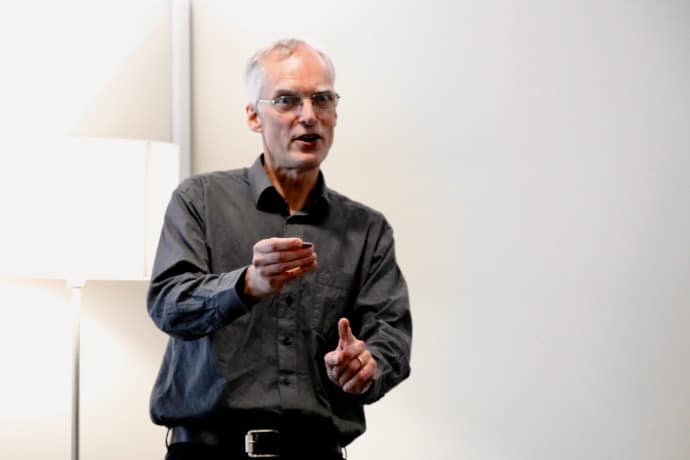“There is no typo in the title: While the similarity with Cubism is fully intended, QBism is not an art movement but a radically new way to make sense of quantum theory. The name derives from Quantum Bayesianism, a precursor of QBism. In this talk I will explain what QBism is and how it changes the way we look at the world,” said Ruediger Schack of the Department of Mathematics Royal Holloway, University of London. Schack was presenting the first seminar of the second STIAS semester and is at STIAS along with project colleagues Christopher Fuchs of the University of Massachusetts, Richard Healey of the University of Arizona, Thomas Ryckman of Stanford University and Jacques Pienaar of the International Institute of Physics, Brazil.
The group has worked on this project at STIAS since 2012 and Schack described the work at STIAS as having “been crucial to the development of the field”.
“QBism (pronounced ‘cubism’) is an interpretation of quantum mechanics – the Q – that takes an agent’s actions and the resulting personal consequences for the agent as the central concerns of the theory,” he said.
“This contrasts with the usual talk we hear from physicists of (passive) observers, macroscopically defined quantum measurements, and objective measurement outcomes,” he added.

People matter
“Basically the message of QBism is that people (more generally, ‘agents’) matter – that people play a creative function in the world. Quantum mechanics therefore does not provide an objective, agent-independent description of the world – it rules out a ‘view from nowhere’,” said Schack.
Schack explained that in QBism, there are no objective elements of reality that determine outcomes or probabilities of outcomes. Rather, every quantum measurement is an action on the world by an agent using their judgment and experience that results in the creation of something new. It implies that the world does not evolve according to an objective mechanism.
He explained that the B initially stood for Bayesian which accounts for probabilities but this is now regarded as too narrow, so currently it is ‘Bettabilitarian’. “This basically means that the world is bettable,” he said, “and implies that any agent can bet or predict future expectations on the basis of past experiences.”
“The interpretation is distinguished by its use of a subjective Bayesian account of probabilities to understand the quantum mechanical Born rule (the means by which quantum theory calculates probabilities) as a normative addition to good decision making,” he added.
“This means probability depends on previous experiences and beliefs.”
“However, the Born rule is not a law dictating what the world must do, but a statement about how each of us can strategise to best survive and prosper in an unruly, only partially controllable world,” he continued.
He explained the way quantum mechanics uses wavefunctions – not to describe the world, but to navigate it. “A wavefunction is a mathematical object to capture the probability of finding a particle at a given position,” he said. “However, in QBism wavefunctions are personal to the agent using it to guide his or her actions.”
“Quantum Bettabilitarianism – QBism – is therefore a tool that helps agents to gamble on the consequences of their actions,” he continued. “According to QBism, quantum mechanics is a theory that any agent can use to better survive in the world, based on his or her prior experience. The laws of quantum mechanics are not laws of nature, but tools that help agents to navigate the world and tell us how to act optimally.”
The multidisciplinary group, which Schack described as “a lucky meeting of minds”,will use its current visit to STIAS to explore new directions in this field and to debate aspects of the ontology and phenomenology of QBism.
Michelle Galloway: Part-time media officer at STIAS
Photograph: Christoff Pauw
